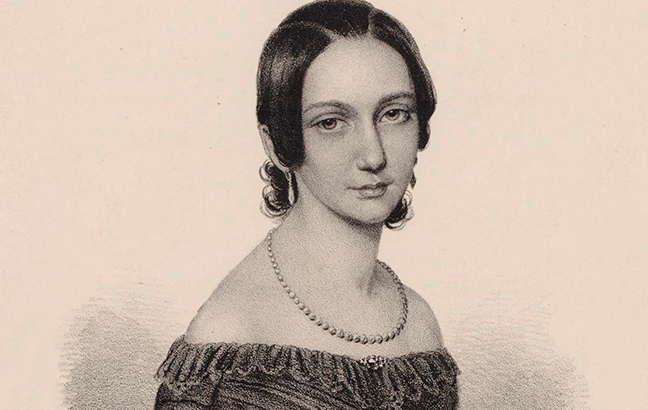Clara Schumann: A Complete Biography
Introduction
Clara Schumann (1819–1896) was one of the most distinguished pianists and composers of the 19th century. Not only was she a child prodigy, she went on to become a pioneering woman in the male-dominated world of classical music. Known primarily during her lifetime as a performer, her compositions are now celebrated for their emotional depth and technical brilliance. Clara was also the wife of composer Robert Schumann and a close friend of Johannes Brahms, two of the leading figures in Romantic music. Over her long and eventful life, she redefined the role of women in music and left a lasting legacy as both artist and muse.

Childhood
Clara Josephine Wieck was born on September 13, 1819, in Leipzig, Germany. Her father, Friedrich Wieck, was a well-known music teacher, and her mother, Marianne Tromlitz Wieck, was a renowned singer and pianist. Clara’s parents separated when she was just five years old, and custody was awarded to her father, who oversaw her musical education with extreme rigor.
Under her father’s disciplined guidance, Clara studied piano, violin, theory, harmony, composition, and counterpoint. By the age of nine, she was performing in public concerts and had already impressed audiences with her technical skill and interpretative depth. Her early training was intensive, with a clear goal: to make Clara one of Europe’s premier pianists.
Youth
Clara’s first major tour took place when she was just eleven years old, traveling to Paris and other European cities. She earned acclaim for her performances and was praised by musical giants such as Goethe and Chopin. During this time, she also began to compose, publishing her Quatre Polonaises, Op. 1 at the age of eleven.
In 1835, at the age of 16, Clara met the young composer Robert Schumann, one of her father’s piano students. Despite Friedrich Wieck’s disapproval, Clara and Robert fell in love. After a lengthy legal battle with her father, the two married on September 12, 1840, the day before Clara’s 21st birthday. This marked the beginning of a fruitful yet challenging partnership.
Adulthood
Clara Schumann’s adult life was a balancing act between motherhood, performance, and composition. She bore eight children and managed her household while supporting Robert’s increasingly fragile mental health. Despite these responsibilities, Clara continued to tour Europe, performing works by Beethoven, Chopin, and especially her husband. Her performances helped to establish Robert Schumann’s reputation across the continent.
Tragedy struck in 1854 when Robert was committed to an asylum following a mental breakdown. He died two years later in 1856. Clara, devastated but resilient, devoted herself to preserving and performing Robert’s works. She also developed a deep friendship with Johannes Brahms, who supported her emotionally and professionally.
Throughout the second half of the 19th century, Clara Schumann was recognized as one of Europe’s foremost pianists. She taught at the Hoch Conservatory in Frankfurt and was admired for her integrity, intelligence, and artistry.
Major Compositions
Though her output was relatively small compared to her contemporaries, Clara Schumann’s compositions are notable for their lyricism, sophistication, and emotional depth. Some of her most important works include:
- Piano Concerto in A minor, Op. 7 (1833–1835): Composed between ages 13 and 16, this virtuosic concerto was premiered with Felix Mendelssohn conducting.
- Romances for Violin and Piano, Op. 22 (1853): A beautiful set of character pieces showcasing her lyrical style.
- Lieder (Songs): Clara composed many songs, often in collaboration with Robert, such as Sechs Lieder, Op. 13, which demonstrate her deep sensitivity to poetry and vocal writing.
- Piano Works: Her Soirées musicales, Op. 6, and Romances, Op. 11 are celebrated for their expressiveness and elegance.
Clara’s music was often overshadowed by her role as Robert’s wife and Brahms’s confidante, but her compositions are now receiving renewed interest and acclaim.
Death
Clara Schumann died on May 20, 1896, in Frankfurt at the age of 76. She had suffered a stroke shortly before her death. She was buried next to her husband in Bonn, Germany. By the time of her death, Clara had not only secured her place as one of the 19th century’s greatest pianists but had also laid the groundwork for future generations of women in music.
Conclusion
Clara Schumann’s life was one of extraordinary talent, perseverance, and influence. She was not only a musical prodigy and virtuosic performer but also a devoted wife, mother, and artist. In a time when women were rarely accepted as serious composers or public figures, Clara carved out a space for herself through sheer brilliance and determination. Her legacy endures, not only in her own compositions but in the careers she helped shape and the barriers she helped break. Today, she is rightly celebrated as a central figure in the Romantic era and a trailblazer for women in classical music.

Comments are closed